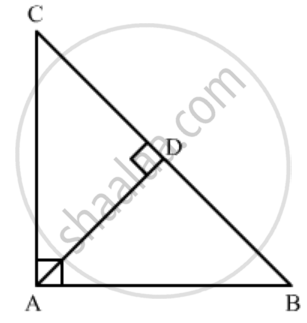Advertisements
Advertisements
प्रश्न
∆ABC is a right triangle right-angled at A and AD ⊥ BC. Then, \[\frac{BD}{DC} =\]
पर्याय
- \[\left( \frac{AB}{AC} \right)^2\]
- \[\frac{AB}{AC}\]
- \[\left( \frac{AB}{AD} \right)^2\]
- \[\frac{AB}{AD}\]
Non of the above
उत्तर
Given: In ΔABC, `∠A = 90^o` and `AD ⊥ BC`.
To find: BD: DC

\[\angle CAD + \angle BAD = 90^o . . . . . \left( 1 \right)\]
\[\angle BAD + \angle ABD = 90^o. . . . . \left( 2 \right) \left( \angle ADB = 90^o \right)\]
\[\text{From (1) and (2)}, \]
\[\angle CAD = \angle ABD\]
In ΔADB and ΔADC,
\[\angle ABD = \angle CAD \left( \text{Proved} \right)\]
\[ \therefore ∆ ADB~ ∆ ADC \left( \text{AA Similarity} \right)\]
\[ \Rightarrow \frac{CD}{AD} = \frac{AC}{AB} = \frac{AD}{BD} \left( \text{Corresponding sides are proportional} \right)\]
APPEARS IN
संबंधित प्रश्न
D and E are points on the sides AB and AC respectively of a ΔABC. In each of the following cases, determine whether DE║BC or not.
AB = 11.7cm, AC = 11.2cm, BD = 6.5cm and AE = 4.2cm.
In a ΔABC, AD is the bisector of ∠A.
If AB = 6.4cm, AC = 8cm and BD = 5.6cm, find DC.

In each of the figures [(i)-(iv)] given below, a line segment is drawn parallel to one side of the triangle and the lengths of certain line-segment are marked. Find the value of x in each of the following :

In ∆PQR, M and N are points on sides PQ and PR respectively such that PM = 15 cm and NR = 8 cm. If PQ = 25 cm and PR = 20 cm state whether MN || QR.
In ∆ABC, P and Q are points on sides AB and AC respectively such that PQ || BC. If AP = 3 cm, PB = 5 cm and AC = 8 cm, find AQ.
In ∆ABC, AD and BE are altitude. Prove that\[\frac{ar\left( ∆ DEC \right)}{ar\left( ∆ ABC \right)} = \frac{{DC}^2}{{AC}^2}\]
There is a staircase as shown in the given figure, connecting points A and B. Measurements of steps are marked in the figure. Find the straight line distance between A and B.

The areas of two similar triangles are in respectively 9 cm2 and 16 cm2. The ratio of their corresponding sides is ______.
A chord of a circle of radius 10 cm subtends a right angle at the centre. The length of the chord (in cm) is
∆ABC is such that AB = 3cm, BC = 2cm, CA = 2.5cm. If ∆ABC ~ ∆DEF and EF = 4cm, then perimeter of ∆DEF is ______.
